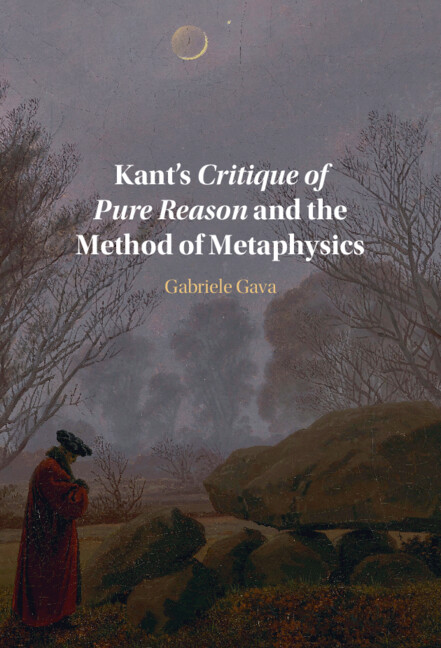
The main claim of Kant’s Critique of Pure Reason and the Method of Metaphysics (Cambridge University Press 2023) is that the Critique of Pure Reason should be read as the doctrine of method of metaphysics. One way to clarify the meaning of this claim is to say that it proposes a new perspective on Kant’s contention that the critique of pure reason, understood as a specific discipline that is established within the pages of the Critique,[2] is tasked with investigating whether metaphysics can become a science. Traditionally, this contention is linked to Kant’s project of faculty analysis, namely his investigation into our different faculties of cognition with the aim of determining which a priori philosophical cognitions are actually in our reach. While I do not deny that faculty analysis is essential to Kant’s philosophical project, I suggest that it is not what characterizes the critique of pure reason as the discipline that it is.
Kant begins the Transcendental Doctrine of Method by distinguishing between two tasks carried out by the Critique in view of its main aim. These are performed by the Transcendental Doctrine of Elements and the Transcendental Doctrine of Method, respectively. The former is responsible for providing ‘an estimate of the building materials’ and for determining ‘for what sort of edifice, with what height and strength, they would suffice’. By contrast, the latter is concerned ‘not so much with the materials as with the plan’ and aims ‘at an edifice in relation to the supplies given to us that is at the same time suited to our needs’ (A707/B735).[3]
I will come back to the ‘needs’ to which Kant refers here later. What I want to point out is that the role of the critique has customarily been linked to the task that Kant ascribes to the Transcendental Doctrine of Elements. The critique establishes that metaphysics as a science is possible by showing that the ‘materials’ that will form that science are in our reach. Arguably, these ‘materials’ are the a priori representations that are singled out in the Transcendental Aesthetic and the Transcendental Logic and the valid synthetic a priori judgements that we can obtain on their basis. The arguments that are responsible for establishing these materials are indeed central to Kant’s philosophical project. However, we face a problem when we focus on them to characterize the critique of pure reason as an independent discipline with aims and procedures of its own. For the Critique, in establishing those materials, does not do something fundamentally different from the parts of metaphysics that are responsible for them. At best, it anticipates what will form an integral part of metaphysics.
One way to put my claim that the Critique of Pure Reason is the doctrine of method of metaphysics is to say that we can better characterize the critique of pure reason as an independent discipline and determine what it does for establishing the possibility of metaphysics as a science if we focus on the task that Kant ascribes to the Transcendental Doctrine of Method, namely the task of providing a ‘plan’ of metaphysics.
In order to clarify what the critique does with respect to this ‘plan’, it is useful to zoom in on what doctrines of method are for Kant. He distinguishes between the doctrine of method of general logic and the doctrines of method of particular sciences. The former provides general instructions regarding how we can attain systematicity in science, where systematicity is essential to providing scientific status to a discipline for Kant. By contrast, doctrines of method of particular sciences identify rules or procedures that are specific to a particular science.
When I claim that the Critique is the doctrine of method of metaphysics, I use the term in this second meaning. Doctrines of method of particular sciences have fundamentally two tasks in my account. First, they provide methodological rules for how to proceed in a given science. These rules are object- or cognition-dependent since they are specific to the objects or cognitions of a particular science. Applying them in other sciences would constitute a mistake. For example, rules of this kind are identified in the Discipline of Pure Reason when Kant distinguishes between mathematical and philosophical cognitions with the aim of identifying methodological rules that are specific to the latter.
Second, doctrines of method provide a description of a science that allows us to see the different cognitions belonging to it as forming a unitary whole, which can be clearly separated from other sciences. Additionally, thanks to this description, we are able to see the ordering that we give to those cognitions as not arbitrary and as resting on their very nature. It is in this sense that the Transcendental Doctrine of Method provides a ‘plan’ of metaphysics. Kant uses a technical term in order to characterize the role of doctrines of method with respect to this plan. Doctrines of method must show that a science has ‘architectonic unity’, where architectonic unity is achieved in relation to an ‘idea’ given a priori by reason: ‘I understand by a system, however, the unity of the manifold cognitions under one idea. This is the rational concept of the form of a whole, insofar as through this the domain of the manifold as well as the position of the parts with respect to each other is determined a priori’ (A832/B860). This ‘idea’ is precisely the description of the science to which I just referred. It identifies the nature of a science and, in so doing, it allows us to see its cognitions as forming a unity and to regard the ordering we give to them as non-arbitrary (See Kant’s Critique of Pure Reason and the Method of Metaphysics, Ch. 1).
Kant hints at the idea of metaphysics that can provide architectonic unity to it when he claims that the Transcendental Doctrine of Method shows that the plan of metaphysics is ‘suited to our needs’ (A707/B735). It is in What Does it Mean to Orient Oneself in Thinking? that Kant explicitly identifies a theoretical and a practical need of reason. While the former has to do with reason’s demand for complete explanations, the latter is determined in connection to the highest good, understood as a necessary practical end of human reason (see 8: 139). Kant further claims that this practical need is the basis of a rational belief in God, which is achievable by a human being with common, but morally healthy, reason, and accords ‘with the whole end of his vocation’ (8: 142).
If we take into consideration this connection between needs and ends of reason, on the one hand, and between the highest good and our vocation (Bestimmung), on the other, it is possible to identify with precision what the idea that can provide architectonic unity to metaphysics is, according to Kant. For in the Architectonic of Pure Reason he introduces a concept of philosophy, which he calls its ‘worldly concept’ (Weltbegriff), that includes reference to these topics as its main characteristic. According to this concept, ‘philosophy is the science of the relation of all cognition to the essential ends of human reason’ (A839/B867). Among these ends, there is one highest or final end, which ‘is nothing other than the entire vocation of human beings, and the philosophy of it is called moral philosophy’ (A840/B867).
Accordingly, in Chapter 1, I claim that Kant considers the worldly concept of philosophy to be the idea according to which metaphysics can attain architectonic unity. This means first of all that using another idea as a guiding principle for organizing metaphysical cognitions would be inappropriate, exactly because this would exclude from it something that is both essential to its very nature and crucial for identifying relationships of importance between those cognitions. If we ordered metaphysical cognitions leaving out the reference to essential ends and the highest good, we would provide an inadequate ordering that would not bestow architectonic unity. We could at best achieve ‘technical unity’, which, in my account, is a unity that is arbitrary, where we do not have reasons to prefer one ordering to any other.
Kant claims that doctrines of method ‘are certainly the latest to be reached, once the science is already long complete’ (A52/B76). This is due to the fact that we need to grasp the specific nature of the cognitions belonging to a science in order to isolate methodological rules that apply specifically to them and to identify the idea that gives unity to them. Importantly, the Critique of Pure Reason appears here to constitute an exception in comparison with other doctrines of method, since it does not come at the end of metaphysics. Rather, Kan often suggests that the realization of his metaphysical system is something that he plans for after the critical investigation is completed. However, it would be misleading to think that the Critique can accomplish its task as the doctrine of method of metaphysics in total absence of some doctrinal parts of the latter.
Here, seeing the Critique as a doctrine of method allows us to illuminate, on the one hand, the relationship between transcendental philosophy and the critique of pure reason and, on the other, the division of labour between the Transcendental Doctrine of Elements and the Transcendental Doctrine of Method. Recall that the Transcendental Doctrine of Elements had to do with the ‘materials’ of the edifice of metaphysics, while the Transcendental Doctrine of Method investigated the ‘plan’. Similarly, Kant suggests that the Critique contains cognitions belonging to transcendental philosophy (A14/B28), which he considers an integral part of metaphysics as a whole (A845/B873). I take this to mean that the Critique of Pure Reason includes parts of metaphysics and that these are instrumental to accomplishing its task, which is establishing the critique of pure reason as the doctrine of method of metaphysics.
Accordingly, I distinguish between two disciplines that are established within the Critique: transcendental philosophy, as one part of metaphysics, and the critique of pure reason, as that discipline within the Critique that achieves the latter’s aim as the doctrine of method of metaphysics. The former investigates a priori concepts for the cognition of objects that do not contain anything empirical (see Kant’s Critique of Pure Reason and the Method of Metaphysics, 5, 12, 70). The latter uses the results of this investigation to carry out its own purposes, as for example identifying methodological rules that are specific to that investigation (in the Discipline of Pure Reason) or showing that the results of that investigation can form a coherent part of a system of metaphysical cognitions organized in accordance with the worldly concept of philosophy. Now this, it seems to me, confirms what I suggested at the beginning of this section, namely that if we want to identify what characterizes the critique of pure reason as an independent discipline with aims and procedures of its own, we should focus not on its investigations regarding the ‘materials’ of metaphysics, but on those concerned with the ‘plan’.
[1] The content of this blog is taken from a section of: Gabriele Gava, ‘The Nature of the Critique of Pure Reason and the Architectonic Unity of Metaphysics: A Response to my Critics’, Kantian Review, early view, DOI: 10.1017/S1369415423000493. I thank the editors of the journal and Cambridge University Press for granting permission to reuse these materials here.
[2] I use ‘Critique of Pure Reason’ (in italics and with capitalization) to refer to Kant’s book in its entirety. By contrast, I use ‘critique of pure reason’ (in roman font and without capitalization) to refer to a particular discipline which Kant develops within the Critique.
[3] Quotations from the Critique of Pure Reason use A and B to refer to its first and second edition, respectively. Quotations from the Akademie Ausgabe of Kant’s works refer to volume and page number. Translations are from the Cambridge Edition of the Works of Immanuel Kant.

Latest Comments
Have your say!